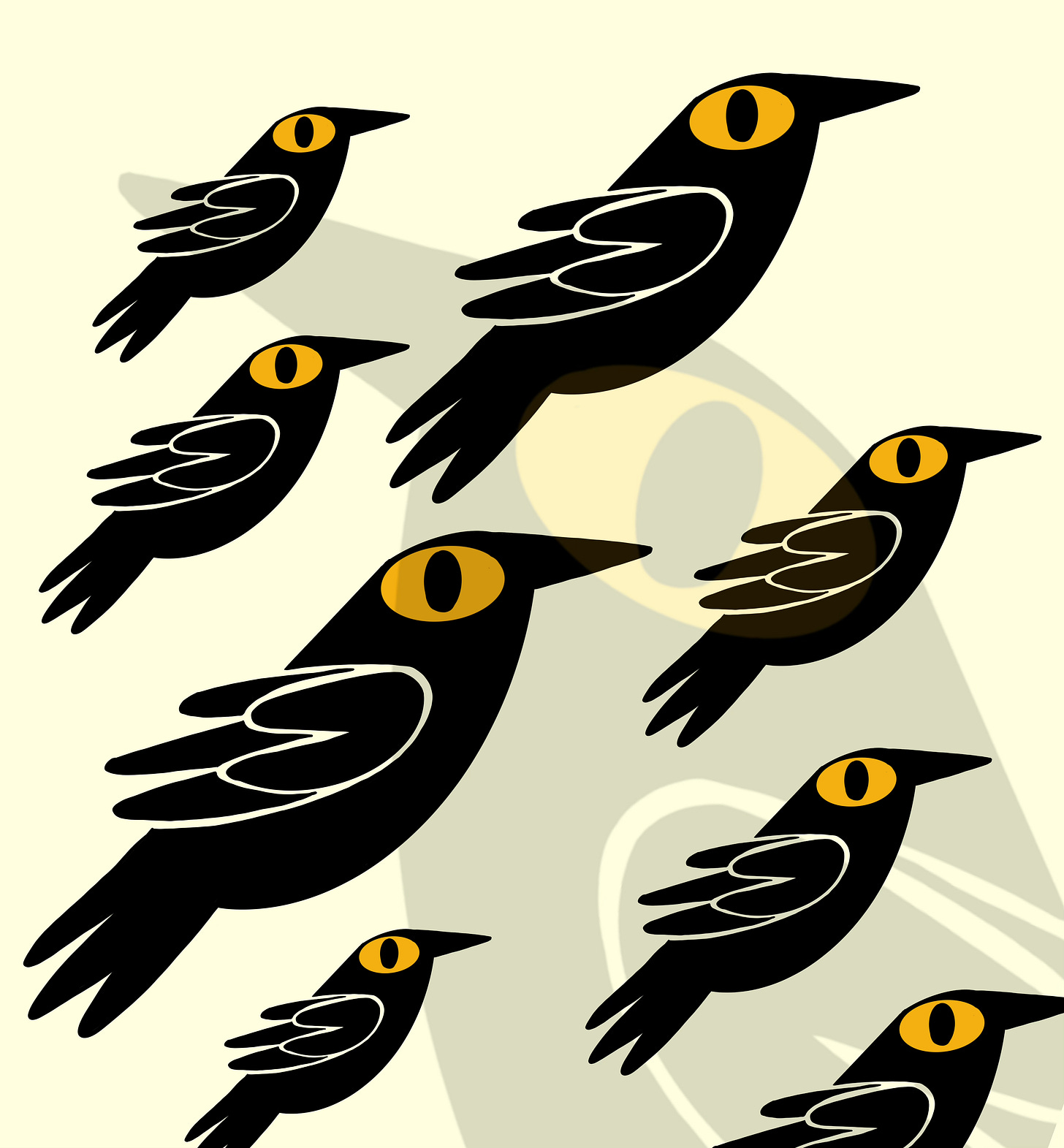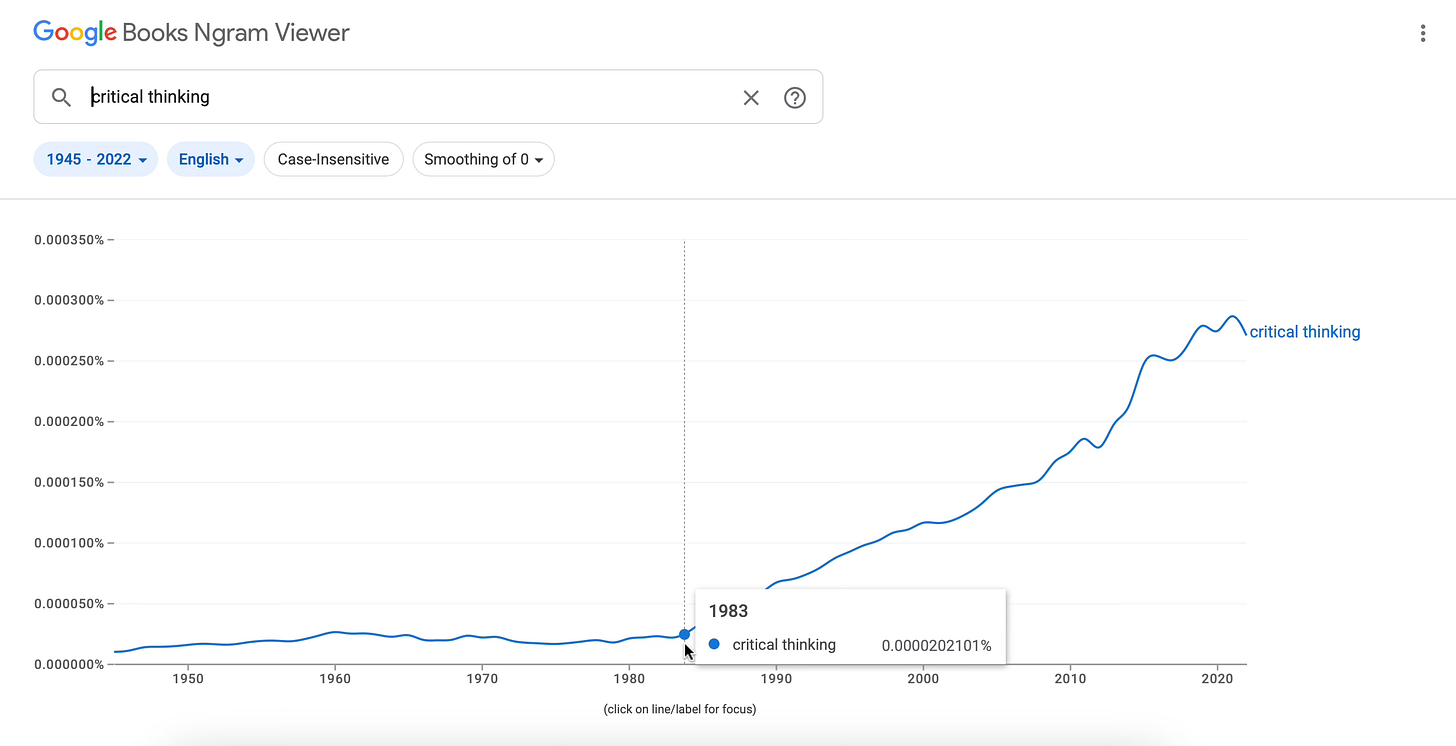What the hell even is critical thinking?
Everywhere I scroll, I hear this.
Before we start, thanks so much for clicking on the link and coming here or opening the email if you are already subscribed.
To the 1.5 people who were wondering where did the audio blogs or podcast go? I have stopped uploading audio directly on Substack. Substack’s constant UX design changes were throwing me off. So Substack will primarily be to read and I am planning to start a Spotify channel independent of Substack, where I will upload the audio.
The other day I was listening to a true-horror story about a job interview. An hour of questions, tasks, hypotheticals and a rejection. When asked for feedback, the interviewer said, the candidate lacked ‘critical thinking’. There are some moments when we feel that technology hasn’t evolved for us to do some specific things. In this case, it was showing the full extent of disappointment at the banality of the interviewer’s feedback. I mean, which circle hell do these recruiters end up in?
Is it just me or is there a slight increase in the phrase ‘critical thinking’ in the popular vocabulary? Every other day, for the past few months, I come across an article or a reel on social media about why critical thinking is important more than ever now. Spiritual gurus who talk about planetary movements preach about the audience’s lack of critical thinking or even my high school physics teacher, who answers to why something happens by saying; “some kind of magic”.
Before we start going on to understand why everyone is obsessed with this phrase, I think it is important to define what Critical Thinking is.
There is no clear definition or consensus on what exactly critical thinking is.
The dictionary defines it as “Critical thinking is the process of analysing available facts, evidence, observations, and arguments to make sound conclusions or informed choices.”
Some say it started with the concept of reflective thinking. The American philosopher John Dewey, who was also quite deep into reforming education, was the one who came up with reflective thinking.
He defined it as; active, persistent and careful consideration of any belief or supposed form of knowledge in the light of the grounds that support it, and the further conclusions to which it tends.
Phew, that’s a mouthful.
In simple words; looking at what we know in the light of all evidence to support it and then coming to conclusions based on that. But I think it goes even beyond that. Etymologically speaking, both the words ‘critical’ and ‘thinking’ have quite interesting origins.
Critical comes from the Greek word kritikós, which means ‘able to make judgments’. Which itself has a Proto-Indo-European root word *krei-. Which means “to sieve”. The same sieve with the meaning of a kitchen utensil I use while making chai.
The second word fascinates me even more. Not because it has some convoluted origin and complex semantic evolution, but because the exact opposite of that. Even from the Proto-Indo-European root word *teng-, it has remained fairly the same. To think is to ponder, to think is to mull over something in the head, to think is to feel inside the head, to think is to be human.
On a side note, ChatGPT says it’s ‘thinking’ when the background code is being executed and the user is waiting. A clever UX design (read UX writing) element to make the machine seem more human.
Coming back to the definition of Critical Thinking. If we stitch together the history of these two words, we see Critical thinking as the process of perceiving and understanding things by filtering the noise to make a judgment.
A more concrete way of understanding critical thinking is using Bloom’s Taxonomy. Bloom's taxonomy is a framework for categorizing the aims and objectives of education. It was developed by a committee headed by a guy called Benjamin Samuel Bloom. He was the guy who pushed the way of teaching that’s focused on the teacher directly “teaching” to students, a one-to-many “knowledge delivery” approach. Not a big fan of this, so kinda conflicted with a framework that has his name and is about learning.
Nevertheless, Bloom’s taxonomy puts the student’s learning objectives into six types: knowledge (recall of ideas), comprehension (demonstrating understanding of ideas), application (putting ideas into practice), analysis (contrasting and relating ideas), synthesis (combining ideas), and evaluation (judging ideas through criteria). Critical thinking primarily revolves around the latter three, that is analysis, synthesis and evaluation.
So critical thinking is essentially something with a very fluid definition, but all revolving around the process of mental exercise to come up with the most sane and to some extent, quite objective judgement. Why is it only getting popular now? Okay, that’s not completely true. People have been raving about critical thinking for quite some time. If we search for the term in Google Books Ngram Viewer, we see that the number of times the phrase ‘critical thinking’ appeared in prints has a sharp uptick in 1983.
Do you know what else happened in 1983, apart from the release of the best Star Wars movie—Return of the Jedi? 1983 was the official beginning of the internet and the first mobile phone call was made.Coincidence much? Not really. The age of information was at dawning upon us and it was only natural that the year started with the release of a book called, ‘Critical Thinking: A Guide to Evaluating Information’.
Yet, the phrase ‘critical thinking’ has only become part of the popular vocabulary on social media relatively quite recently. I feel like the phrase ‘critical thinking’ has become a shorthand for dealing with some messy and sloppy systems. Yet I do agree that it’s getting more and more difficult to use critical thinking in its many forms.
Well to start with, AI is a decent enough material that can take any shape, especially convoluted hallucinations and intentional misinformation. All it requires is a medium versatile enough to carry this information and we have laid down the groundwork for this way long back with social media.
On the other side of the equation, the use of AI is atrophying critical thinking muscles in our brains. A couple of months ago, Microsoft along with Cambridge published a paper called ‘The Impact of Generative AI on Critical Thinking: Self-Reported Reductions in Cognitive Effort and Confidence Effects From a Survey of Knowledge Workers’. The real question hiding there is, do we really need to think critically for everything? I do understand that, this line of questioning is real slippery slope.
Along with the finding that critical thinking muscle is shrinking, the paper also mentions that if someone has higher confidence in the AI’s ability to perform a task correlates with a reduced critical thinking effort.
Outside the technology bubble, the modern world is generally becoming unbearable to live in. Am I going to succumb to a mental health crisis or an environmental catastrophe fuelled by rapid climate change. Am I going to be fired from my day job or burned out by the ever-increasing demands of the industry? Am I going to succumb to this economy or implode with everything going on inside me?
Among all this, how can anyone expect people to think critically? To that extent, I am even going to call critical thinking a luxury and a privilege.
~deep breath~
Practically there is a need to think critically. Like the influencers say, all the reason it is more important now. But how?
There are a ton of tutorials and guides. From the most SEO-optimised method to niche subReddits and obscure Instagram influencers to growth hackers in LinkedIn.
Most of these methods starts with a clear objective of winning arguments. I kinda understand where they are coming from, because I love good arguments. I mean, what are dialogues but arguments with different levels of disagreement? Wait, is critical thinking just an argument with oneself? huh
These popular techniques talk about understanding heuristics, understanding systems, vetting the source and ten other steps.
I don’t know maybe the answer is to just take a pause.
This has to be one of the least self-aware things I have said till now. Because taking a pause is something I can’t do. Don’t think I could ever pause. Either it’s a complete flow or a sudden stop. Add three parallel thoughts and a background song into the mix. It feels like the 2X button and the skip buttons have taken over the pause button everywhere. Talking about design elements, a single user’s effort to take a pause is directly against the effort of thousands of talented designers and researchers who have spent years perfecting the perfect hypnosis patterns on the screen.
If I am able to pause, then the next step is to be doubtful of everything. Some say it’s trust issues, I call it skepticism.
So here is my simple framework for short attention span critical thinking.
Step 1: Pause
Possible phrases to say; “Hold on”, “Wait a minute”, “Hmm”, “Huh”
Step 2: Unbridled skepticism
Possible comments to make; “Really?”, “That sounds too good to be true”, “In this economy?”, “Excuse me, someone’s messaging me” And quickly add a new search tab (Don’t mind my 400 open tabs here).
Do I do this all the time? hell no!
Do I wish I did this all the time? Actually no. It’s still so much work.
Keeping up with the topic of critical thinking and beautiful designs, I am learning tarot card reading. So if you want to know the future using Tarot from a complete skeptic and an atheist. Hit me up.
Links:
Suggestion Corner
Please watch this!
please please please please please please please please please please please please




Yeay! Blooms taxonomy for the win.
How much of critical thinking should one have to make a judgement that another person doesn't have critical thinking? Or were they just being unnecessarily critical? Or worst trying to not get people who thinks into the team because they'll object a chance of social validation of being the most intellectual person in the entire world with a question, a healthy criticism.
The etymological roots sounds really cool. Its like they really thought about bit and searched far and wide. :D
Very actionable framework - Pause. Skepticism.
But I must say, very hard to apply during those brainrot scrolling sessions worrying about how unbearable the world is becoming.
Slowly realising the root of all issues are the phone and the internet. I hate when parents are right.
Being the 1/1.5 people who listen to audio, I guess I'll be moving to spotify then.
Never liked substack. I don't know why. It felt very off from the start.
So, parting words, fuck substack and their agile, lean and all the digital product design bullshit. Fuck the leeches preying on human vulnerabilities. And finally fuck HRs the biggest Scum of The Earth.
See you on the other side.